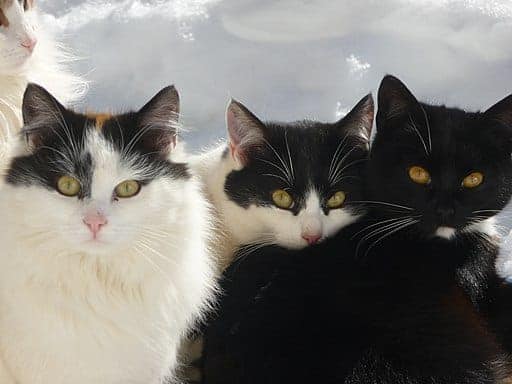
Here’s everything you need to know about the health of the Japanese Longhair Bobtail: what the common diseases are, how to spot them and how to treat them.
Taking care of your four-legged friend implies taking care of his health scrupulously. Only in this way, in fact, will we be able to ensure that our cat’s life is long, serene and happy by our side. Let’s go through the list of common diseases of the Japanese Longhair Bobtail together, to find out everything about its health.
Health of the Japanese Longhair Bobtail

The Japanese Longhair Bobtail tends to be in good health.
In fact, not only the average duration of its life is about 16 years, but this cat is not predisposed to the onset of particular hereditary pathologies.
However, this does not make it immune to diseases that commonly affect domestic cats, including:
- Viral diseases such as FeLV, FIV and FIP;
- Gingivitis;
- Obesity;
- Diabetes.
FeLV, FIV and FIP
These are three very serious diseases, potentially fatal for the cat.
The modes of transmission of the viruses that cause Feline Viral Leukemia, Feline Viral Immunodeficiency and Feline Infectious Peritonitis are the same.
In fact, the infection is transmitted through the exchange of biological fluids, through direct contact between animals, but also from the mother to the kittens.
These pathologies cause the cat’s immune defenses to lower, making it exposed to infections and a greater chance of developing tumors.
What to do to protect the health of your Japanese Longhair Bobtail? Currently, there is only one vaccine against FeLV.
In other cases, it is essential to subject the cat to veterinary checks and sterilization or neutering, avoiding that it comes into contact with stray cats.
Gingivitis
Gingivitis is a very common condition in cats. As can be seen easily, this is an inflammation of the cat’s gums.
Among the main symptoms of this disease, there are:
- Swelling, redness and irritation of the gums
- Ache;
- Difficulty in chewing;
- Decreased appetite;
- Gum bleeding;
- Halitosis;
- Loss of teeth.
So that gingivitis does not turn into a periodontal pathology, it is essential to intervene promptly in order to understand the causes that caused its onset.
Of course, a very important role belongs to prevention : it is essential, in fact, to take care of the health of the oral cavity of the Japanese Longhair Bobtail. How to do?
On the market there are special toothbrushes and toothpastes for cats, or practical spreadable creams to be distributed on the cat’s teeth to counteract the accumulation of tartar and plaque.
Obesity
The Japanese Longhair Bobtail is a decidedly greedy cat; therefore, the risk of accumulating excess weight is just around the corner!
Obesity is a serious disease, which in turn can lead to the onset of other dangerous diseases, including:
- Hepatic lipidosis;
- Joint problems;
- Heart disease;
- Diabetes;
- Arthritis;
- Skin disorders.
Among the main causes of diabetes in cats are: a sedentary lifestyle, incorrect nutrition and aging. How to help your Japanese Longhair Bobtail lose weight and get healthy again?
The best advice is to contact your vet, who will be able to formulate a specific food plan based on factors such as the cat’s age, weight, health conditions and lifestyle.
Diabetes
Another disease that could compromise the health of our Japanese Longhair Bobtail is diabetes.
As we have seen, obesity is one of the main causes of its onset. An incorrect diet, consisting of an excessive amount of carbohydrates, is the basis of the manifestation of this pathology.
Additional factors that can provoke its appearance are:
- Genetic predisposition of the Burmese breed;
- Age over 7 years;
- Male sex.
Diabetes is a metabolic disease that prevents the body from regulating blood sugar. Responsible for this is a hormone, called insulin.
Low or no insulin production causes excess sugar to remain in the bloodstream, being excreted in the urine.
In this way, the cells are unable to take advantage of the energy taken from this substance, falling back on fats and proteins and causing severe imbalances. The main symptoms of the disease are:
- Increased thirst
- Increased frequency of urination;
- Increased appetite.
The treatments to which the diabetic cat can be subjected include a strict food plan and insulin-based drug therapy.






